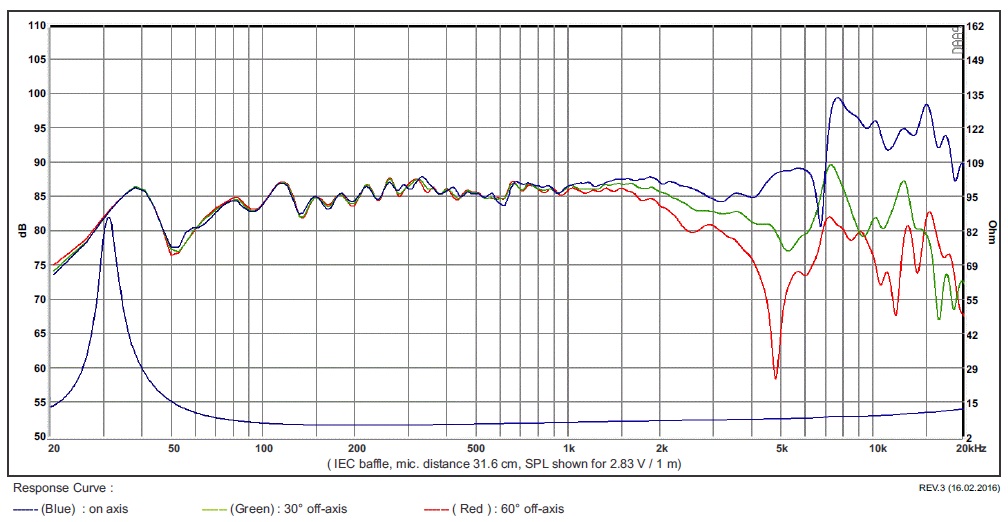This new SB17 is really exceptional in my eyes. It's cone profile is almost flat at 3-5,5" which gives it uniquely flat treble and still it has low Fs. It should be all right also as midrange crossed say 3-400 and 3500Hz LR2 or elliptic/duelund.
Double 10" or single 15" for bass and waveguide+3/4" tweeter in wide baffle like this http://www.hifi-journal.de/news/2-lautsprecher/108-high-end-2016-heco-direkt-dreiklang-video
Double 10" or single 15" for bass and waveguide+3/4" tweeter in wide baffle like this http://www.hifi-journal.de/news/2-lautsprecher/108-high-end-2016-heco-direkt-dreiklang-video
An externally hosted image should be here but it was not working when we last tested it.
Last edited:
Just the perfectionist in me...You would not want to cross that high anyway for off axis reasons.
It's directivity between 2-4kHz will be perfect match with a shallow waveguide tweeter like this Monacor WG-300 and Vifa XT25TG by kimmosto Wave guides & horns

An externally hosted image should be here but it was not working when we last tested it.

Last edited:
5th,
very nice "Waves" design. Simple and smart.
edit: Göran, nice job on measurements and the overall DIY projects and web site.
Thank you!
I've order two pairs of SB17CRC35-8 (Rohacell) drivers and it will be interesting to see how they perform compared to the SB17NAC35-4 driver.
Stay tuned for new measurements!
Regards
/Göran
2kHz is a good compromise for 6" drivers, but if you can go down to 1.5kHz then all the better.
In order for this to be true, the baffle can not be wider than the driver - right?
The dispersion is govern by the baffle and can never be "wider" than what the baffle allows. And the baffle can never be less wide that the driver. Right?
//
In order for this to be true, the baffle can not be wider than the driver - right?
The dispersion is govern by the baffle and can never be "wider" than what the baffle allows. And the baffle can never be less wide that the driver. Right?
//
No this isn't correct.
Baffle width (or cabinet width with curved/faceted speakers) determines how a monopole loudspeaker will transition from 2pi to 4pi radiation (ie when bafflestep occurs). Diffraction occurs when the wave-front, produced by the driver(s), interacts with the baffle edges. What impact this has depends on the distance between the driver and the baffle edges and then the shapes/geometry encountered at the baffle edges. Severe changes in geometry, such as the 90 degree angle of a box are the worst for this.
In any of the above circumstances the actual dispersion profile of standard monopole loudspeakers is dictated by the off axis response of the drivers and is generally only looked at from the perspective of 2pi radiation, ie hemispherically, or 180 degrees about the front firing face of the loudspeaker.
With dipoles the baffle width directly affects the dispersion. The baffle width determines the maximum frequency at which the front and rear waves, produced by the driver, can properly interact with one another. Go too high in frequency and the driver, regardless of its size, will radiate hemispherically and no dipole interaction will occur.
This is why both JohnK and Linkwitz have designed loudspeakers using truncated baffles and ever smaller drivers, to increase the frequency range that the loudspeaker can actually provide dipole radiation over.
And thanks guys for the kind words about my website, I figured it was about time!
And thanks guys for the kind words about my website, I figured it was about time!
Nice work with the website!
It's a lot more work than many realize.
Looking forward to read more about your designs.
Regards
/Göran
An OEM version of this driver is used in the Revel M106. They use an 8 ohm version with a black anodised cone. Review here
http://www.stereophile.com/content/revel-performa3-m106-loudspeaker#uxSUzvyCwO7Q4tdk.97
http://www.stereophile.com/content/revel-performa3-m106-loudspeaker#uxSUzvyCwO7Q4tdk.97
- Status
- This old topic is closed. If you want to reopen this topic, contact a moderator using the "Report Post" button.
- Home
- Loudspeakers
- Multi-Way
- SB Acoustics SB17NAC35-4 measurements!